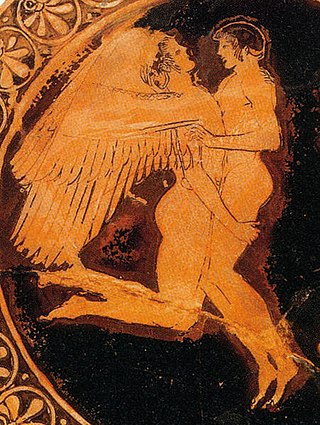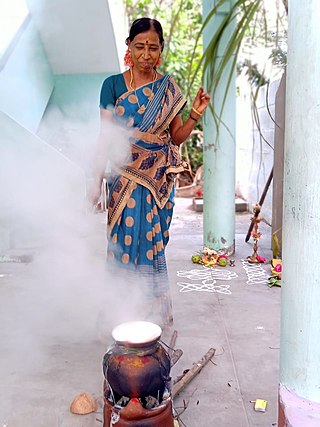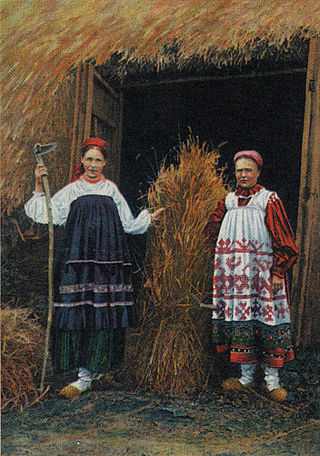Related Research Articles

May Day is a European festival of ancient origins marking the beginning of summer, usually celebrated on 1 May, around halfway between the spring equinox and summer solstice. Festivities may also be held the night before, known as May Eve. Traditions often include gathering wildflowers and green branches, weaving floral garlands, crowning a May Queen, and setting up a Maypole, May Tree or May Bush, around which people dance. Bonfires are also part of the festival in some regions. Regional varieties and related traditions include Walpurgis Night in central and northern Europe, the Gaelic festival Beltane, the Welsh festival Calan Mai, and May devotions to the Blessed Virgin Mary. It has also been associated with the ancient Roman festival Floralia.

Bihu is a set of three important cultural festivals unique to the Indian state of Assam – 'Rongali' or 'Bohag Bihu' observed in April, 'Kongali' or 'Kati Bihu' observed in October or November, and 'Bhogali' or 'Magh Bihu' observed in January. The festivals present an admixture of Tibeto-Burman, Austroasiatic and Indo-Aryan traditions entwined so intricately that it is impossible to separate them—festivals which are uniquely Assamese to which all communities of Assam had contributed elements. The Rongali Bihu is the most important of the three, celebrating spring festival. The Bhogali Bihu or the Magh Bihu is a harvest festival, with community feasts. The Kongali Bihu or the Kati Bihu is the sombre, thrifty one reflecting a season of short supplies and is an animistic festival.

Hyacinth or Hyacinthus is a gentle and clever divine hero and a lover of Apollo from Greek mythology. His cult at Amyclae southwest of Sparta dates from the Mycenaean era. A temenos or sanctuary grew up around what was alleged to be his burial mound, which was located in the Classical period at the feet of Apollo's statue. The literary myths serve to link him to local cults, and to identify him with Apollo.

Pongal, also referred to as Thai Pongal (தைப்பொங்கல்), is a multi-day Hindu harvest festival celebrated by Tamils in India and Sri Lanka. It is observed at the start of the month Thai according to Tamil solar calendar, and this festival is celebrated usually on January 14 or January 15 depending on the sun's orbit around earth that particular year. It is dedicated to the sun god, Surya, and corresponds to Makar Sankranti, the harvest festival under many regional names celebrated throughout India. The three days of the Pongal festival are called Bhogi Pongal, Surya Pongal, and Mattu Pongal. Some Tamils celebrate a fourth day of Pongal known as Kanum Pongal.

Vijayadashami, also known as Dussehra, Dasara or Dashain, is a major Hindu festival celebrated every year at the end of Navaratri. It is observed on the tenth day of the month of Ashvin, the seventh in the Hindu Luni-Solar Calendar. The festival which typically falls in the Gregorian calendar months of September and October.

Makar(a) Sankranti, also referred to as Uttarayana, Makar, or simply Sankranti, is a Hindu observance and a festival. Usually falling on the date of January 15 annually, this occasion marks the transition of the sun from the zodiac of Sagittarius (dhanu) to Capricorn (makara). Since the sun has made this transition which vaguely coincides with moving from south to north, the festival is dedicated to the solar deity, Surya, and is observed to mark a new beginning. Many native multi-day festivals are organised on this occasion all over India.

Holi is a popular and significant Hindu festival celebrated as the Festival of Colours, Love and Spring. It celebrates the eternal and divine love of the god Radha and Krishna. Additionally, the day also signifies the triumph of good over evil, as it commemorates the victory of Vishnu as Narasimha Narayana over Hiranyakashipu. Holi originated and is predominantly celebrated in the Indian subcontinent but has also spread to other regions of Asia and parts of the Western world through the Indian diaspora.

The Gondi (Gōṇḍī) or Gond people, who refer to themselves as "Koitur", are an ethnolinguistic group in India. Their native language, Gondi, belongs to the Dravidian family. They are spread over the states of Madhya Pradesh, Maharashtra, Chhattisgarh, Uttar Pradesh, Telangana, Andhra Pradesh, Bihar, and Odisha. They are listed as a Scheduled Tribe for the purpose of India's system of reservation.
The tribes of Jharkhand consist of 32 scheduled tribes inhabiting the Jharkhand state in India. In 1872, only 18 tribes were counted among the schedule tribes from which Banjara, Bhatudi, Chik Baraik and Mahli were marked as semi-Hindu aboriginal and Kora as proletariat Hindu. In the 1931 census, including above four semi-Hindu aboriginal and Kora, a proletariat Hindu, the number was raised to 26 from 18 by adding four more in the annexure. They were Birajia, Godait, Karmali and Paharia, but Kisan was excluded from the list. In 1941 census, Baga, Bedia and Lohra included again taking Kisan in the annexure and number came to 30 which was prevailing till June 2003. Kanwar and Kol were added on 8 June 2003 in the annexure and the number of Schedule Tribes came to 32.

Bear worship is the religious practice of the worshipping of bears found in many North Eurasian ethnic religions such as among the Sami, Nivkh, Ainu, Basques, Germanic peoples, Slavs and Finns. There are also a number of deities from Celtic Gaul and Britain associated with the bear, and the Dacians, Thracians, and Getians were noted to worship bears and annually celebrate the bear dance festival. The bear is featured on many totems throughout northern cultures that carve them.
The tribal people of Bangladesh are ethnic minorities in Chittagong Hill Tracts (southeastern), Sylhet Division (northeastern), Rajshahi Division (west), and Mymensingh Division (north-central) areas of the country. They are indigenous and the tribal races, total population of ethnic minorities in Bangladesh was estimated to be over 2 million in 2010. They are diverse ethnic communities including Tibeto-Burman, Austric and Dravidian people.

Kartika Purnima is a Hindu, Sikh and Jain cultural festival that is celebrated on Purnima. It falls in November or December of the Gregorian calendar and is also known as Tripurari Purnima or Deva-Deepawali, the gods' festival of lights. Karthika Deepam is a related festival that is celebrated in South India and Sri Lanka on a different date. It follows Diwali by about 15 days.

The Tiwa people, are a Tibeto-Burmese ethnic group primarily inhabiting the Northeast Indian states of Assam, Meghalaya, Arunachal Pradesh, Manipur and Nagaland, and some parts of neighbouring Bangladesh and MyanmarThey were known as Lalungs/Lalong/Laleng in the Assamese Buranjis and in Colonial literature and in the Constitution of India, though members of the group prefer to call themselves Tiwa. Some of their neighbours still call them Lalung.
Tiwa (Lalung) is a Tibeto-Burman (Sino-Tibetan) language spoken by the Tiwa people in Assam and Meghalaya in North East India. Tiwa language is similar to Boro, Dimasa, Kokborok and Garo language of India.
The Amis people of Taiwan celebrate many small and larger harvest festivals and ceremonies through the year.

Dożynki is a Slavic harvest festival. In pre-Christian times the feast usually fell on the autumn equinox, in modern times it is usually celebrated on one of the Sundays following the end of the harvest season, which fall on different days in different regions of Europe.

Wanshuwa (Tiwa: Wanshúwa) is an important religious festival of the Tiwa living in Amkha and Marjong villages in Karbi Anglong district. It is celebrated once in five or six years. Generally, this festival takes place between June and August. The ceremony usually starts on a Tuesday and ends on a Thursday. The main function takes place on a Wednesday at the residence of Shangdoloi, the head of the village bachelor's dormitory where the "sham" are located. These mortars are partly buried underground and arranged in a circular pattern. While dancing to the rhythm of the khram, pangsi and thurang members of the Shamadi pound the wet rice with a "lomphor" till rice is ground to a powder. After the dance, the grounded rice flour is mixed lightly with water and is used to sprinkle on people present at the ceremony. The remaining flour is distributed among the villagers to prepare wanrusa, a type of steamed rice cake. The next morning they bring the wanrusa to the Shangdoloi’s house and offer it to the deities Sodonga Raja and Maldewa Raja. By the late evening of Thursday, the Wanshuwa festival comes to an end. The Tiwa of the Amkha and Marjong group considers the Wankuri or the flour pounded on the day of the Wanshuwa festival to be sacred rice.
Musical Instruments of the Tiwa tribe add to the rhythm of the festivals of the Tiwa tribe. Traditional musical instruments plays a major role in enrichment of the Tiwa culture. Through Tiwa musical instruments every Tiwa celebrates all the colourful Tiwa festivals or occasion. A list of some of the popular musical instruments of the Tiwa people are given below;

Pureiromba is a God in Meitei mythology and religion. He is the giver of rain and agricultural prosperity. He is one of the major Umang Lai deities. He is the Ancestor God of the Angom clan of the Meitei ethnicity.
References
- ↑ Expert, NE Travel (2020-04-19). "THE TIWA TRIBE". NE Tribe. Retrieved 2021-11-17.
- ↑ "SOGRA MISAWA BEING CELEBRATED BY THE TIWA COMMUNITY - INSIDE NE" . Retrieved 2021-11-17.
- ↑ "Tiwa Community Festivals Issues and analysis @ abhipedia Powered by ABHIMANU IAS". abhipedia.abhimanu.com. Retrieved 2021-11-17.
- ↑ Patar, Raktim (2021-02-14). The Tiwa Ethnohistory. Notion Press. ISBN 978-1-63745-518-0.